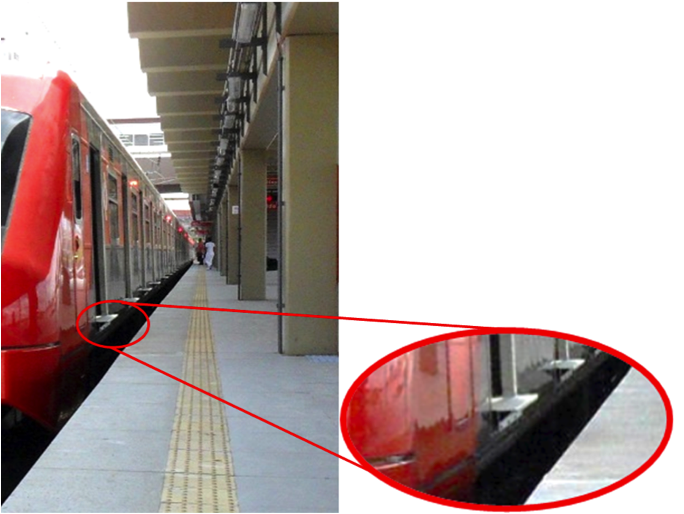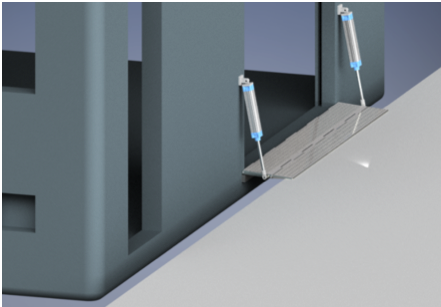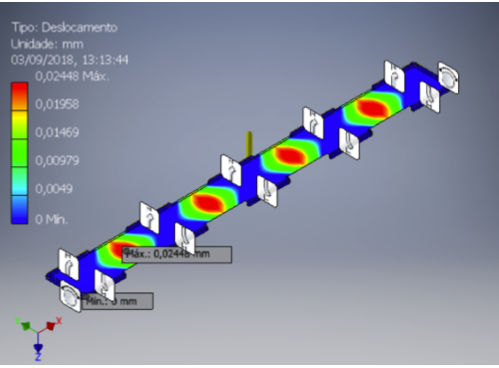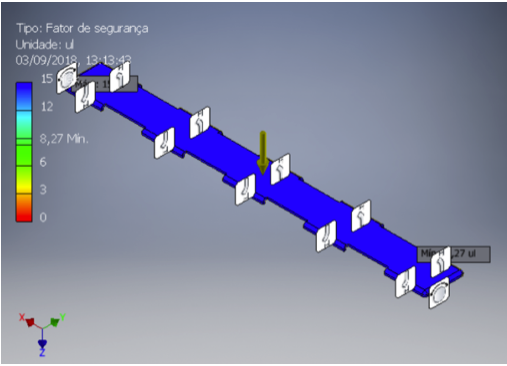

Vol. 40 (Issue 38) Year 2019. Page 20
KLEINKAUF, Bernardo T.U. 1; PELLENZ, Eduarda V. 2; SOUZA, José D. 3 & SPORKET, Frederico 4
Received: 21/06/2019 • Approved: 15/10/2019 • Published 04/11/2019
ABSTRACT: This paper approaches a study to improve the accessibility in the subways of the company TRENSURB in the metropolitan region of Porto Alegre / RS. Due to rifts like the rift between the boarding platform and the car compromises the accessibility of the disabled. One of the solutions presented was an automatic ramp design that facilitates the embarkation and disembarkation of the passengers, avoiding possible injuries in the same or the employees who assist them. In addition to presenting the project, the paper aims to highlight the difficulties that people with physical disabilities still face in locomotion in large urban centers. The ramp was designed in stainless steel 304 automatically with opening and closing during the wagon stop. |
RESUMEN: Este artigo aborda um estudo com a finalidade de melhorar a acessibilidade nos metrôs da empresa TRENSURB na região metropolitana de Porto Alegre/RS. Devido a desníveis como o vão entre a plataforma de embarque e o carro a acessibilidade das pessoas portadoras de deficiências fica comprometida. Uma das soluções apresentadas foi um projeto de rampa automática que facilita o embarque e o desembarque dos passageiros, evitando possíveis lesões nos mesmos ou nos funcionários que os auxiliam. Além de apresentar o projeto o paper tem como objetivo destacar as dificuldades que as pessoas com deficiência física ainda enfrentam na locomoção em grandes centros urbanos. A rampa foi projetada em aço INOX 304 de forma automática com abertura e fechamento durante a parada dos vagões. |
The absence of accessible places is the reality of many people seen as incapable of performing specific activities (Paiva & Barbosa, 2017). Accessibility is the equalization of opportunities, providing free access to urban space. The defense of the quality of life and social integration are essential aspects for a democratic society that develop policies of inclusion in a participatory manner and equal opportunities (Ashton & Heidrich, 2011).
Understanding Assistive Technology (TA) as an essential area for different perimeters of contemporary society is critical to the debate about the inclusion of the disabled person. Because it is a relatively new field, related to multidisciplinary studies, the researches in the area are still growing and adding up in national territory (Soares et al., 2017).
The excellent population concentration imposes, for public management, such challenges as housing, infrastructure, transportation, as well as essential health and education services (Pinheiro et al.,2016). Locomotion systems are used by the public without the perception of the importance of accessibility and safety until damage occurs and results in victims or causes discomfort or inconvenience (Avci & Ozbulut, 2018).
Free traffic plans have several purposes. A primary objective of establishing a free fare system is to increase the number of passengers in transit to attract drivers in transit to relieve traffic congestion, reduce automobile-related air pollution and greenhouse gas emissions (predominantly CO2) by reducing fossil fuel consumption and reducing the financial cost for the construction of new roads or the maintenance of existing roads (Myung-Jin, Ji-Eun, Hyun-Ju, 2018).
Equal access to opportunities has emerged in public transport planning as a social objective that many transport agencies are trying to achieve (Grisé et al., 2019). Yet in practice, not all public transport agencies are currently providing urban residents with comparable levels of service due to physical barriers in the public transport network that can significantly hinder the ability of individuals with physical disabilities to access opportunities. In countries without a strong federal accessibility act and/or with major financial constraints, some public transport agencies fall behind in applying universal access design principles, making it even harder for people with a physical disability to access opportunities (Lessa, Lobo, Cardoso, 2019).
Accessibility of public transport is becoming an important problem, especially for city planners and public transport experts (Zając, 2016).
Streets can be made more liveable by ensuring that they are accessible to everyone. This requires the identification of ways to overcome the barriers to access for those who are socially excluded (Mackett, Achuthan, Titheridge, 2008).
This project carried out the study of a ramp to provide accessibility in the subway wagons of the TRENSURB line, from Novo Hamburgo to Porto Alegre in southern Brazil. The study points to a solution proposing a device adapted to vehicles, a ramp able to eliminate the rift between the platform and the train.
Densely populated regions use urban trains for locomotion of people. The main advantages of using this means of transport, linking the urban center with the downtown area, is the speed in the displacement, the capacity to take more people, occupying less physical space, low pollution index and the security presence in this equipment (Germani, Quintas, Gomes, 2018).
Urban trains and subways are an essential means of locomotion in Brazil. An important aspect is the quality of transport regarding availability, stocking, and safety (Fedatto Neto & Gomes, 2017). The passenger transport service is the combination of the features of the transport services that allow meeting the specific needs of the passengers as intended. The concept of a passenger transport service must take account of consumer needs (Sokolov, 2019).
Transport policies should consider socioeconomic classes dependent on public transport. Transportation policies should consider socioeconomic classes dependent on public transportation (Seo & Nam, 2019).
The subway is a means of urban transportation that circulates on rails. This has been shown to be the most efficient transport for large cities because it offers some advantages, such as providing an attractive service for users of other modalities such as the bus and the car, collaborating with the reduction of vehicles circulating on public roads and, consequently, reducing the rate of congestion, traffic accidents and environmental degradation (Rieg et al., 2015).
The CPTM (Companhia Paulista de Trens Metropolitanos) uses a ramp to assist in the embarkation and departure of the wheelchair users. A portable ramp is used by employees who set it between the car and the platform. Another aspect of being highlighted is that subways and freight trains use the same lines existing the need for the existence of the rift because the freight wagons are more extensive than those of passengers.
Space makes it difficult for people, especially wheelchairs, who, even in projects already developed to reduce the space between the wagons and the platform, find difficulties due to the unevenness that the adaptations present (Borba et al., 2016). As can be seen in Figure 1, the circulated device is fixed to the subway car doors.
Figure 1
Device to reduce the space between
the subway car and the platform

As can be seen in figure 1, the projected ramp does not cover the space between the subway car and the loading platform.
Accessibility appears precariously in the company TRENSURB, where there are different sizes of rifts, which vary from station to station, as we see in the measurements presented in table 1.
Table 1
Measures of the rift of the Trensub wagons
in the metropolitan region of Porto Alegre/RS
Station |
Old subway |
New subway |
||
------------ |
Space (cm) |
Height (cm) |
Space (cm) |
Height (cm) |
Novo Hamburgo |
10.0 |
3.0 |
10.0 |
9.5 |
Fenac |
12.7 |
3.0 |
9.5 |
6.0 |
Industrial |
12.7 |
3.0 |
9.5 |
7.0 |
Santo Afonso |
12.9 |
3.0 |
11.0 |
6.0 |
Rio dos Sinos |
15.6 |
3.0 |
13.0 |
2.0 |
São Leopoldo |
12.7 |
3.5 |
13.6 |
3.0 |
Unisinos |
11.9 |
-2.0 |
15.5 |
* |
Sapucaia |
12.7 |
* |
18.0 |
4.0 |
Luiz Pasteur |
13.0 |
* |
10.0 |
1.5 |
Esteio |
12.5 |
* |
12.6 |
3.0 |
Petrobrás |
12.5 |
-4.5 |
17.0 |
* |
São Luís |
15.0 |
* |
13.0 |
* |
Mathias Velho |
12.0 |
* |
10.0 |
7.0 |
Canoas |
15.0 |
4.5 |
* |
4.0 |
Fátima |
17.0 |
-2.0 |
18.0 |
4.0 |
Niterói |
19.4 |
-2.0 |
11.0 |
* |
Anchieta |
13.7 |
-3.0 |
20.0 |
-3.0 |
Aeroporto |
18.5 |
-3.0 |
12.0 |
* |
Farrapos |
16.0 |
* |
12.6 |
4.0 |
São Pedro |
22.0 |
* |
25.4 |
5.5 |
Rodoviária |
20.0 |
4.0 |
26.0 |
* |
Mercado |
14.7 |
8.0 |
6.5 |
3.5 |
* Values of unevenness or rift are less than 1 cm
The differences affect the loading and unloading of people with physical disabilities and people in general.
In the access of the wheelers are embarked on the back with the help of trained employees, who often when helping the wheelchair can suffer some injury because of the force to overcome the rift between the train and the platform. Besides, there are frequent accidents with drunk people, the elderly, and children who put their feet in the cleft.
Even receiving employee help and guidance, such as taking a long step to board or disembark, still run the risk of accidents.
Finite element analysis (FEA) is a computerized method for predicting how a product reacts to real-world forces such as vibration, heat, fluid flow, and other physical effects. Finite element analysis shows whether a product will break, wear out, or function as designed. Although called analysis, in the product development process, it is used to predict what will happen when you use the product.
Element analysis (EA) divides a real object into a large number of finite elements, such as small cubes. Mathematical equations help predict the behavior of each element. Then a computer sums all individual actions to predict the functioning of the object.
Finite element analysis helps to predict the behavior of products affected by many physical effects, including several situations such as mechanical stress analysis, which was the central assessment made in this project.
Autodesk Inventor Professional software provides scaling and simulation tools for designing, visualizing, and simulating full 3D digital prototypes.
This software used in this study provided the viability to optimize and validate product performance without the need to build a real prototype. The simulation environment provided support for static and modal finite element analysis (FEA) simulation of parts and projected assembly.
The virtual prototype of the ramp has a total length of 1710 mm. The required ramp width should cover the most significant space found between the train and platform, which is 260 mm. The entire width of the ramp was of 400 mm, divided into three parts to be able to adapt in all the stations. The virtual prototype of the ramp is shown in figure 2.
Figure 2
Virtual prototype

The thickness needed to resist bending occurred from the maximum load applied. Simulations were performed to verify the operation of the ramp.
The calculations showed the need for a ramp 8 mm thick, 400 mm wide and 1710 mm long; to increase its resistance and to allow the thickness to be smaller, ribs were added and the diameter reduced to 3 mm. In Figure 3, the virtual tests performed can be seen.
Figure 3
Virtual prototype under test (Part I)

The tensile test was carried out with a maximum displacement of 0.02448 mm and a safety factor of 8 ul when there is a force of 5000 N. The material used must be the same as that used in the manufacture of subway cars, which is 304 stainless steel.
Figure 4
Virtual prototype under test (Part II)

Accessibility must provide access to urban space in a free and universal way. The use of transport is fundamental for the quality of life and social integration of the citizen in society.
Access to transportation for the disabled is an essential service. Improvements in the transport of subways are necessary as can be seen in the cases of the metropolitan region of Porto Alegre, as well as in São Paulo.
The ramp designed and tested by computational means is only a validated alternative to meet the need in existing subways. The supply of factory-built wagons will be the best alternative in the future. Therefore, changes and modifications are unnecessary.
The elimination of spaces between wagons and platforms in new subway lines projects will be essential to address and correct this problem that occurs in existing structures.
This study is part of projects of a group of researchers of Teachers and Mechanics students of the Fundação Escola Técnica Liberato Salzano Vieira da Cunha (http://www.liberato.com.br/ ) from Novo Hamburgo, Brazil. The research group does not receive any funding to support it.
Ashton, M. S. G., Heidrich, R. (2011). Accessibility Public politics: tourist destinations development factor [in Portuguese]. Espacios Vol. 32 Issue 4 pp. 15.
Avci, O., Ozbulut, O. (2018) Threat and vulnerability risk assessment for existing subway stations: A simplified approach Author links open overlay panel Case Studies on Transport Policy Vol. 6, Issue 4 pp. 663-673 DOI: 10.1016/j.cstp.2018.08.005
Borba, A. P., Souza, J. D., Haupt, W., Souza, F. R. de O., Sporket, F., Rossini, E. G., Reis, B. P. (2016) Microstructural Analysis of Corrosion of Welded Joints in Stainless Steel used in Manufacture of Bioreactors IJRES Int. Journal of Research in Eng. and Science. Vol. 4. Issue 12 pp.37-48
Fedatto Neto, M., Gomes, H. M. (2017) Analysis of vibration levels in users of urban trains [in Portuguese]. Revista Liberato Vol. 18, Issue 29, pp 75-95. DOI: 10.31514/rliberato.2017v18n29.p75
Germani, A. B., Quintas, J. P. R., Gomes, H. M. (2018) Evaluation of vibration levels in light rail vehicle users in Porto Alegre [in Portuguese]. Revista Liberato Vol. 19, Issue 32, pp 203-214. DOI: 10.31514/rliberato.2018v19n32.p203
Grisé, E., Boisjoly, G., Maguire, M., El-Geneidy, A. (2019) Elevating access: Comparing accessibility to jobs by public transport for individuals with and without a physical disability Practice Vol. 125 pp. 280-293.DOI: 10.1016/j.tra.2018.02.017
Lessa, D. A., Lobo, C., Cardoso, L. (2019) Accessibility and urban mobility by bus in Belo Horizonte/Minas Gerais – Brazil Journal of Transport Geography Vol. 77 pp. 1-10
Mackett, R. L., Achuthan, K., Titheridge, H. (2008) AMELIA: making streets more accessible for people with mobility difficulties Urban Design International Vol. 13, Issue 2 pp. 81–89
Myung-Jin, J., Ji-Eun, J., Hyun-Ju, A. (2018) The welfare effects of the free subway fare scheme for seniors: A discrete choice approach with the case of Seoul Case Studies on Transport Policy Vol. 6, Issue 4, pp. 642-650. DOI: 10.1016/j.cstp.2018.08.003
Paiva, R. R. B., Barbosa, A. C. L. (2017). Accessibility in the physical aspects of UFERSA, Pau dos Ferros/RN Multidisciplinary Center. [in Portuguese]. Espacios Vol. 38 Issue 29 pp. 13.
Pinheiro, D. R., Guardabassio, E. V., Bonjardim, E. C., Bresciani, L. P. (2016) The development of Brazilian cities according to the HDI-M and the IBEU [in Portuguese]. Espacios Vol. 32 Issue 37 pp. 14
Rieg, D. L., Scramim, F. C. L., Valentine, B. A., Da Mata, B. F., Pexiolini, G. C. (2015) Quality Assessment in Metropolitan Transportation Service through the Adaptation of the SERVPERF Instrument [in Portuguese]. Espacios Vol. 36 Issue 10 pp. 2
Seo, W., Nam, H, K. (2019) Trade-off relationship between public transportation accessibility and household economy: Analysis of subway access values by housing size Cities Vol. 87 Issue pp. 247-258. DOI: 10.1016/j.cities.2018.11.004
Soares, J. M. M., Fontes, A. R. M., Ferrarini, C. F., Borras, M. A. A., Braatz, D. (2017). Assistive technology: revision of aspects related to the topic [in Portuguese]. Espacios Vol. 38 Issue 13 pp. 8
Sokolov, Y. I., Ivanova, E. A., Anikeeva-Naumenko, L. O., Lavrov, I. M. (2019) Improving passenger transportation service as a part of tourism services complex in Russia Espacios Vol. 40 Issue 6 pp. 1
Zając, P. A. (2016) City Accessible for Everyone – Improving Accessibility of Public Transport Using the Universal Design Concept Transportation Research Procedia Vol. 14 pp. 1270-1276. DOI: 10.1016/j.trpro.2016.05.199
1. Fundação Escola Técnica Liberato Salzano Vieira da Cunha bernardoueda@hotmail.com
2. Fundação Escola Técnica Liberato Salzano Vieira da Cunha duds.pellenz@gmail.com
3. Fundação Escola Técnica Liberato Salzano Vieira da Cunha josesouza@liberato.com.br
4. Fundação Escola Técnica Liberato Salzano Vieira da Cunha frederico.sporket@liberato.com.br